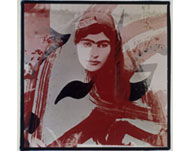A word about Middle Eastern art
The British Museum is showcasing one of the largest collections of contemporary Middle Eastern art.

Venetia Porter, curator of the Word Into Art exhibition, which runs from May 18 until early September, said it showcases the work of 84 artists inspired by the written word.
Rather than traditional Islamic calligraphy, Word Into Art focuses on new ways of using and interpreting the written word.
The featured artists experiment with cutting up, rearranging, abstracting and deconstructing the Arabic, and sometimes Persian and Latin, script.
 |
|
Image of Imaginations, by |
“Ninety per cent of our public won’t really know what Arabic looks like … this material is difficult. It’s unusual for most of our public. Very few people will have seen anything like this before,” Porter told Aljazeera.net.
As an introduction to the exhibition, the museum produced a visitor’s guide detailing the Arabic alphabet, explaining its sacred associations, and translating many of the poems referenced in the works.
Sacred script
The range of work is huge: Canvases, paper, sculptures, photography and mixed media.
Four sections explore different approaches to the central theme: Sacred Script, in which artists are inspired by Quranic verses; Literature and Art, featuring traditional poetry and writing; Deconstructing the Word, a look at the use of letters in abstract art; and History, Politics and Identity, featuring works that pertain to cultural and social issues.
 |
|
Updating a Family Album, |
Along with a range of Arab, Persian and Israeli artists from across the Middle East and North Africa, Word Into Art also includes two celebrated artists from Asia.
The work of Haji Noor Deen Mi Guanjiang of China and Kouichi Fou’ad Honda of Japan, who both studied with prestigious Middle Eastern calligraphers, features innovative reinterpretations of Quranic texts.
They were chosen for the exhibition because “the Arabic calligraphy story has actually a deep resonance, and travels, and it doesn’t just end in the Middle East”, Porter says.
Untold stories
Following the Forgotten Empire exhibition of ancient Persian work, which ended in January, curators at the museum began focusing on “how you can use the collections, the history represented in these objects, to actually look at the region in a different kind of way”, says Porter.
Politics may yet interfere with art: There is uncertainty about what will happen to the work of two Israeli artists if, as hoped, the exhibition travels to Arab countries in the Middle East.
But Porter remains optimistic. “I’d like to think this exhibition isn’t about politics in that way, and that art will rise to the top. I hope.”
Pictures courtesy of The artist/ British Museum